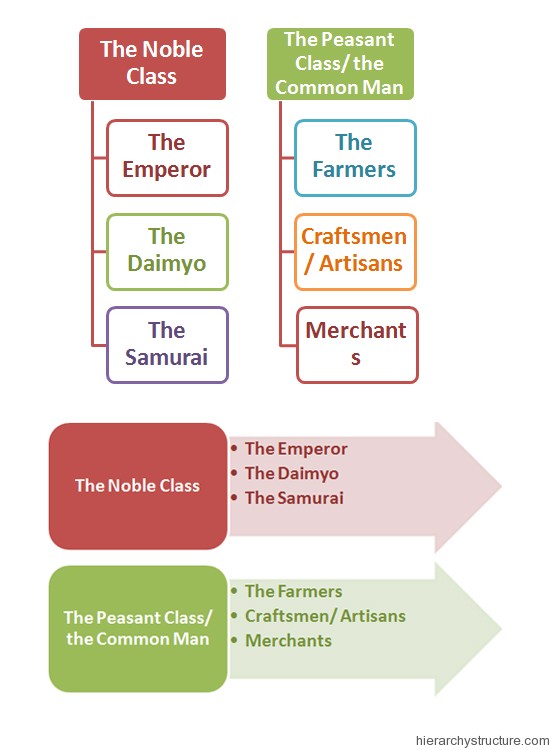The Ancient Japanese Society possessed different Social Classes based on the Power and prestige. Ancient Japanese Hierarchy was majorly divided into two categories namely as the Noble Class and the Peasant Class.
The Noble Class was then further categorized into three more divisions named as the Emperors, the Daimyo and the Samurai whereas the Peasant Class was sub divided into three more categories as the Farmers, the Craftsmen and the Artisans and the last one being the Merchants. The detailed description of this Ancient Japanese Hierarchy is summarized as below:

The Noble Class: The Noble Class was the Uppermost and far more Superior Class than rest of the people in Japan. The Noble Class was further categorized in three more parts in the Ancient Japanese Hierarchy named the Emperors, the Daimyo and the Samurai which are described as below:
- The Emperor: The Emperor was also referred as the King possessed the Supreme Power in all the Classes. The Emperor was equivalent to the God for the countrymen. The order of an Emperor was considered the final decision and no person was allowed to question the order. They ruled the kingdom and handled the administration.
- The Daimyo: The Daimyo were also referred as the Warlords and they got Second Highest Powers in the society lower than the Emperor. They possessed the entire Ancient Japanese Military as well as the Economic Power in the entire Ancient Japanese Hierarchy. They used to possess huge lands hereditarily and they lead the armies to save the land and the workers also. The country’s security was under their leadership and responsibility.
- The Samurai: The armies lead by the Daimyos consisted of the powerful and brave warriors named as Samurai. These heroic warriors were under the leadership of the Daimyos. These warriors possessed extra privileges’ than the common people and also had higher status than others. They protected the entire Nation with their bravery and heroism.
The Peasant Class/ the Common Man: The Common Man or Layman referred as the Peasant Class was the Lowest Class and possessed almost very few or No Powers at all. They performed day to day working which a common man does to earn a livelihood. The Peasant Class was further divided into many Sub-Classes which included Farmers who were the highest ranked Class in these Sub-Classes and then come the Artisans followed by the Craftsmen and in the end, the Merchants. A brief description is as follow:
- The Farmers: The Farmers were the topmost Class in the Peasant Sub-Class in the Ancient Japanese Hierarchy. The Farmers having their own land were Superior to the Farmers not having their own land.
- Craftsmen/ Artisans: These were among the Second Highest Class in the Peasant Sub-Class in the Ancient Japanese Hierarchy and were lower to the Farmers. Their work was with metal and wood and some of them got famous as ardent Samurai Sword makers.
- Merchants: Merchants were among the Lowest Class in the Peasant Sub-Class in the Ancient Japanese Hierarchy because it was thought that their earning is totally dependent on other people’s work.
Know More about Japanese Racial Hierarchy
